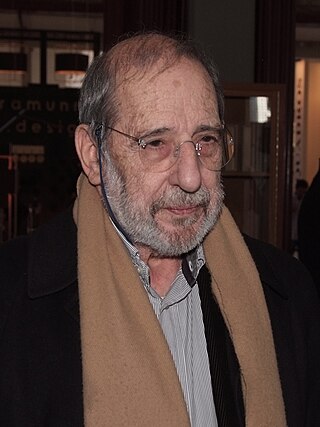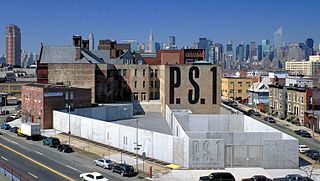
The Pritzker Architecture Prize is an international architecture award presented annually "to honor a living architect or architects whose built work demonstrates a combination of those qualities of talent, vision and commitment which has produced consistent and significant contributions to humanity and the built environment through the art of architecture.” Founded in 1979 by Jay A. Pritzker and his wife Cindy, the award is funded by the Pritzker family and sponsored by the Hyatt Foundation. It is considered to be one of the world's premier architecture prizes, and is often referred to as the Nobel Prize of architecture.

The Museum of Modern Art (MoMA) is an art museum located in Midtown Manhattan, New York City, on 53rd Street between Fifth and Sixth Avenues. The institution was conceived in 1929 by Abby Aldrich Rockefeller, Lillie P. Bliss, and Mary Quinn Sullivan. Initially located in the Heckscher Building on Fifth Avenue, it opened just days after the Wall Street Crash. The museum, America's first devoted exclusively to modern art, was led by A. Conger Goodyear as president and Abby Rockefeller as treasurer, with Alfred H. Barr Jr. as its first director. Under Barr's leadership, the museum's collection rapidly expanded, beginning with an inaugural exhibition of works by European modernists. Despite financial challenges, including opposition from John D. Rockefeller Jr., the museum moved to several temporary locations in its early years, and John D. Rockefeller Jr. eventually donated the land for its permanent site.

The Museum of Contemporary Art (MCA) Chicago is a contemporary art museum near Water Tower Place in downtown Chicago in Cook County, Illinois, United States. The museum, which was established in 1967, is one of the world's largest contemporary art venues. The museum's collection is composed of thousands of objects of Post-World War II visual art. The museum is run gallery-style, with individually curated exhibitions throughout the year. Each exhibition may be composed of temporary loans, pieces from their permanent collection, or a combination of the two.

Álvaro Joaquim de Melo Siza Vieira is a Portuguese architect, and architectural educator. He is internationally known as Álvaro Siza and in Portugal as Siza Vieira.

MoMA PS1 is a contemporary art institution located in Court Square in the Long Island City neighborhood in the borough of Queens, New York City, United States. In addition to its exhibitions, the institution organizes the Sunday Sessions performance series, the Warm Up summer music series, and the Young Architects Program with the Museum of Modern Art. MoMA PS1 has been affiliated with the Museum of Modern Art since January 2000 and, as of 2013, attracts about 200,000 visitors a year.

Sir David Frank Adjaye is a Ghanaian-British architect who has designed many notable buildings around the world, including the National Museum of African American History and Culture in Washington, D.C.. Adjaye was knighted in the 2017 New Year Honours for services to architecture. He received the 2021 Royal Gold Medal, making him the first African recipient and one of the youngest recipients. He was appointed to the Order of Merit in 2022.

Jeanne Gang is an American architect and the founder and leader of Studio Gang, an architecture and urban design practice with offices in Chicago, New York, San Francisco, and Paris. Gang was first widely recognized for the Aqua Tower, the tallest woman-designed building in the world at the time of its completion. Aqua has since been surpassed by the nearby St. Regis Chicago, also of her design. Surface has called Gang one of Chicago's most prominent architects of her generation, and her projects have been widely awarded.

Beatriz Colomina is an architecture historian, theorist and curator. She is the founding director of the Program in Media and Modernity at Princeton University, the Howard Crosby Butler Professor of the History of Architecture and director of graduate studies in the School of Architecture.

The BP Pedestrian Bridge, or simply BP Bridge, is a girder footbridge in the Loop community area of Chicago, United States. It spans Columbus Drive to connect Maggie Daley Park with Millennium Park, both parts of the larger Grant Park. Designed by Pritzker Prize-winning architect Frank Gehry and structurally engineered by Skidmore, Owings and Merrill, it opened along with the rest of Millennium Park on July 16, 2004. Gehry had been courted by the city to design the bridge and the neighboring Jay Pritzker Pavilion, and eventually agreed to do so after the Pritzker family funded the Pavilion.
Architecture criticism is the critique of architecture. Everyday criticism relates to published or broadcast critiques of buildings, whether completed or not, both in terms of news and other criteria. In many cases, criticism amounts to an assessment of the architect's success in meeting his or her own aims and objectives and those of others. The assessment may consider the subject from the perspective of some wider context, which may involve planning, social or aesthetic issues. It may also take a polemical position reflecting the critic's own values. At the most accessible extreme, architectural criticism is a branch of lifestyle journalism, especially in the case of high-end residential projects.
Siri Engberg is curator of visual arts at the Walker Art Center in Minneapolis, Minnesota. She wrote or edited a number of catalogues raisonnés, often with the artist's participation. Engberg organized about a half dozen shows before becoming assistant and then curator, which allowed her to curate several large touring shows and other major exhibitions.

Martin Felsen is an American architect and Fellow of the American Institute of Architects (FAIA). He directs UrbanLab, a Chicago-based architecture and urban design firm. Felsen's projects range in scale from houses such as the Hennepin, Illinois Residence, mixed-use residential and commercial buildings such as Upton's Naturals Headquarters, public open spaces such as the Smart Museum of Art Courtyard at the University of Chicago, and large scale, urban design projects such as Growing Water in Chicago and a masterplan for the Yangming Lake region of Changde, China. Felsen was awarded the 2009 Latrobe Prize by the American Institute of Architects, College of Fellows.

The Lucas Museum of Narrative Art is a museum founded by filmmaker George Lucas and his wife, businesswoman Mellody Hobson. Once completed, the museum will hold all forms of visual storytelling, including painting, photography, sculpture, illustration, comic art, performance, and video. It is under construction in Exposition Park in Los Angeles, California. The museum is expected to open in 2025.

NEMA (Chicago) (also 1210 South Indiana and formerly 113 East Roosevelt or One Grant Park) is a 76-story residential skyscraper in Chicago, Illinois in the Central Station neighborhood, of the Near South Side. The tower, built by developer Crescent Heights, has 800 apartments and rises 896 feet (273.1 m) making it the city's tallest rental apartment building. NEMA is the tenth-tallest building in Chicago as of 2024 and the forty first-tallest building in the United States. It is the tallest all-rental residential building in the city.
Amanda Williams is a visual artist based in Bridgeport, Chicago. Williams grew up in Chicago's South Side and trained as an architect. Her work investigates color, race, and space while blurring the conventional line between art and architecture. She has taught at the California College of the Arts in San Francisco, Sam Fox School of Design & Visual Arts at Washington University in St. Louis, Illinois Institute of Technology, and her alma mater Cornell University. Williams has lectured at the Metropolitan Museum of Art, New Museum, School of the Art Institute of Chicago, and at a TED conference.
Joseph Grima is a British architect, critic, curator and editor. He is the creative director of Design Academy Eindhoven and co-founder of the design research studio, Space Caviar.
SOILED is an architecture magazine released periodically that centers on architecture, design, and the interactions between humans and space. It incorporates the visual elements of design magazines and publishes original writing in the style of a literary magazine. It aims to break down boundaries between architects and non-architects through this combination. Its open submission format allows the publication "to extend the architectural dialogue beyond the community of the discipline to engage the larger public."
Marcelo Spina is an Argentine-American architect (AIA) and educator. He is a partner in PATTERNS, which is a Los Angeles-based architecture firm. He founded PATTERNS in 2002. Since 2001, he has been a Design and Applied Studies Faculty at the Southern California Institute of Architecture, SCI-Arc.
Eva Franch i Gilabert is a Catalan architect, curator, critic and educator based in New York City who works in the fields of contemporary art, architecture, and public space. From 2010 to 2018, she was executive director and chief curator of Storefront for Art and Architecture in New York. From 2018 to 2020, Franch was director of the Architectural Association School of Architecture in London. She is currently a visiting lecturer at Princeton University.
Yesomi Umolu is a British curator of contemporary art and writer who has been director of curatorial affairs and public practice for the Serpentine Galleries since 2020.












